What is Surya Puja? Is it similar to Surya Tilak? How does the phenomenon
work in temples of Tamil Nadu? Which temples in TN have Surya Puja? What is
basis of the Jaipur City Plan?
In a momentous occasion, during the recent Ram Navami festivities, in
Ayodhya which witnessed the Janmotsava of Sri Ram Lalla Virajman in his
birthplace after 500 years, the holy city was soaked in another extraordinary
event - the Surya Tilak ceremony. This sacred ritual, performed on the murty of
Ram Lalla at the Ayodhya temple, marked a significant highlight of the ongoing
celebrations. Notably, the ceremony unfolded at noon, utilizing a system
involving mirrors and lenses within the temple premises.
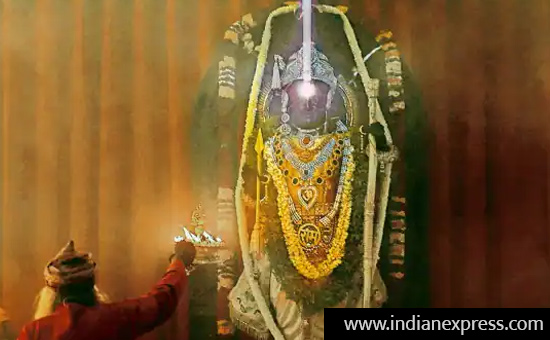 Surya Tilak on Ram Lalla 2024.
Surya Tilak on Ram Lalla 2024.
Surya
Puja and Surya Tilak ie sun on forehead – are they the same thing
We do not have Surya
Tilak in any South Indian temple, but just the phenomenon of sun touching the
main vigraha on specific days of the year periodically without any intervention
of mechanical contrivance.
Throughout history, sacred monuments have served as spaces for
encouraging dialogue between humanity and the divine. The inherent simplicity
and functional design of these structures, coupled with intentional
architectural arrangements, have facilitated the creation of a sacred ambiance
through the manipulation of light.
Various techniques, such as the play of light reflected from walls to
cast mysterious shadows, the gentle filtration of subdued light through
openings, and the strategic use of light as a focal point, have all been
employed to symbolize a fundamental connection to the divine. In this context, natural light emerges as a significant element of
religious symbolism.
Upon entering a temple, one is often greeted by the glare of sunlight,
initiating a journey inward through gradually darkening spaces. Eventually, the
pilgrim arrives at the innermost sanctum, shrouded in total darkness. This
deliberate treatment of light ensures that as the pilgrim progresses towards
the garbhagriha (inner sanctum),
their eyes adjust to the darkness, promoting a state of mind conducive to
worship and free from worldly distractions.
Consequently, the halls preceding the sanctum are maintained in
semi-darkness, while the innermost chamber remains pitch dark. Along this
journey, the pilgrim traverses numerous doorways, collonaded halls, and
corridors leading to sacred spaces beyond.
The sacred carvings adorning the walls, pillars, architraves, and ceilings of these interior compartments leave a profound impact on the devotee's psyche, preparing them for the encounter with the divine. As the devotee approaches the sanctum, they pause at the door, adorned with intricate carvings depicting river goddesses, symbolizing purification from earthly impurities. With mind and soul now focused on the enshrined divinity, the devotee offers worship individually to the deity housed within the sanctum sanctorum.
The phenomenon of
Surya Puja in Tamil Nadu temples encapsulates a spiritual journey guided by the
manipulation of light and architectural design, ultimately leading devotees to
a profound encounter with the divine presence enshrined within the inner
sanctum.
In accordance with the principles of Sthapatya Veda, which governs Indian architecture, the temple and
the surrounding town are designed to reflect the cosmos. Thus, the
architectural layout of the temple and the urban plan are interconnected.
An exemplary instance of this concept can be observed in Jaipur, where Vidyadhara, the city planner, based the city's design on the pithapada mandala. This mandala,
comprising nine squares representing the universe, allocates the central square
to the earth. Similarly, Jaipur's city plan consists of nine large squares, and the central square is designated for the royal palace. Likewise, in temple architecture, the central position,
symbolizing the Earth, is reserved for the Garbhagrha.
With meticulous attention to cardinal orientation, symmetrical
arrangements, and mathematical precision, the Hindu temple encapsulates a
miniature universe within its confines, transcending space and time. The
interior sanctum of the temple, dedicated to a specific deity, is shielded from
the external world and mundane activities by towering walls, cardinal gateways,
and stringent codes of conduct. At the heart of the temple lies the garbhagriha, the womb chamber, where the
presiding deity resides.
This chamber is characterized by its simplicity, resembling a cave-like
enclosure with thick walls that prevent natural light from entering, except
under extraordinary circumstances. The garbhagriha holds multiple symbolic
meanings, representing the primordial state of unity before creation, the
darkness described in Vedic cosmogony, and the womb of the earth from which
life emerged.
The construction of Hindu temples begins with the laying out and
alignment of the vastupurushamandala,
which serves as a blueprint mirroring the cosmos and its expansion from the
point source of creation, characterized by symmetries and mathematical proportions.
This precise alignment, typically towards the east, is crucial to establish a connection between the microcosm of the
temple and the macrocosm of the universe.
Though there are many such constructions throughout Tamil Nadu,
especially in Tanjore district, there are over 60 temples where a remarkable
phenomenon occurs during a few days around the equinox: the light of the rising
or setting sun penetrates the sanctuary and illuminates the presiding deity - a phenomenon known as Surya Puja. This event creates
a surreal effect as sunlight enters the otherwise dim center of the temple.
Do temples in Tamil Nadu use Mirrors?
The
temple architecture is so planned that using the geo-position, the rays enters
the temple through the main entrance all the way inside to the garbhagrha.
Analysis of the dates of 56 Surya Puja events at 52 of these temples in
Tanjore district shows a particularly noteworthy precise alignment of these
events with the solar declination, which refers to the angle of the sun
relative to the celestial equator. The mean solar declination of these Surya Puja events closely matches that of the equinox, which is the time when the sun is directly above the Earth's equator, resulting in nearly equal day and night lengths.
Furthermore, such precision in alignment could have been achieved
through the Indian technique of shadow
casting.
This technique involves the use of shadows cast by specific structures
or objects to determine the position of the sun relative to the Earth. By
carefully observing the length and direction of these shadows, ancient
astronomers and architects could have calculated the exact position of the sun
and aligned the temples accordingly.
This highlights the advanced knowledge and skill of ancient Indian
civilizations in astronomy and architecture, as well as their reverence for
celestial phenomena in the design and construction of sacred spaces like
temples.
This convergence of
celestial and terrestrial alignments underscores the profound spiritual
significance and architectural precision of Hindu temple construction, where
the union of cosmic principles and earthly manifestations is celebrated in a
sacred space.
The Phenomenon
The following is the observation one can have in most of the
traditional temples.
During the Surya Puja ritual, sunlight traverses the temple gateways, imbued with layers of symbolic significance rooted in Hindu cosmology. The three sides of the gateway symbolize the sun's path as it arcs across the sky from horizon to horizon. At the apex of the doorway, two prominent figures often adorn the arch, each holding astronomical symbolism.
Makaras, mythological creatures embodying elements of water, earth, and sky, with bodies reminiscent of crocodiles, elephant noses, and bird wings, are symmetrically placed at the base of the arch. Additionally, river goddesses Ganga and Yamuna, and intertwining water plants emerge from makara's mouth only to be absorbed by the other, representing the cyclical nature of creation and destruction in the universe.
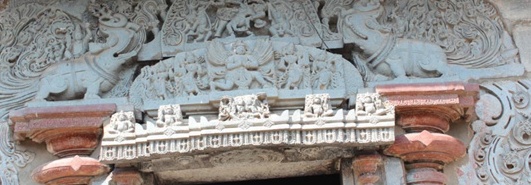 Left and Right of entrance arch are Makaras, centre is Garuda. Belur Temple.
Left and Right of entrance arch are Makaras, centre is Garuda. Belur Temple.
However, not all Hindu temples allow the sun's rays to penetrate the sanctum. Despite being oriented along the east-west axis, certain temple features obstruct the sunlight. For instance, the vahana, the deity's vehicle, often large and enclosed in a pavilion, may block the horizon view.
In Shaivite temples Vrsha being positioned directly on the east-west axis facing the deity, such as at the Brihadeshvara Temple in Tanjore, may hinder the sunrise view. Moreover, the flagstaff, symbolizing the wind and Shiva's boundless expansion, may be precisely aligned with the east-west axis. In some cases, purpose-built walls, like those at the Kailasanatha Temple in Ellora, obstruct the equinox sunlight from reaching the sanctum. At the Sun Temple of Konarak, the Natamandir and a column bearing Surya's charioteer likely impede the entry of light.
In Surya Puja temples, however, these obstructions are either absent or
deliberately offset from the axis to ensure the unimpeded entry of sunlight
into the sanctum.
In Swarnapureeswarar
Temple at Semponarkoil,
near Mayaram, an elaborate twelve-day festival takes place at the temple during
the Surya Puja, occurring in the Tamil month of Chittirai (April-May). The experience of standing in the darkened
garbhagriha with horizontal rays of sunlight sweeping past is described as
profoundly dramatic by devotees, evoking a sense of wonder that transcends the
bounds of a mere natural phenomenon.
Similarly, at the temple of Vaitheeswarankoil (associated with
planet Mars, it is one more of the Navagraha Temples near Kumbakonam)
devotees recount a similar sense of awe-inspiring wonderment during the event. They describe how the moving light of the evening sun seemingly traces a circuit inside the temple, passing up one side of the flagstaff of Shiva and returning to the sun on the other side. To see album of Navagraha Temples (this is first temple in album)
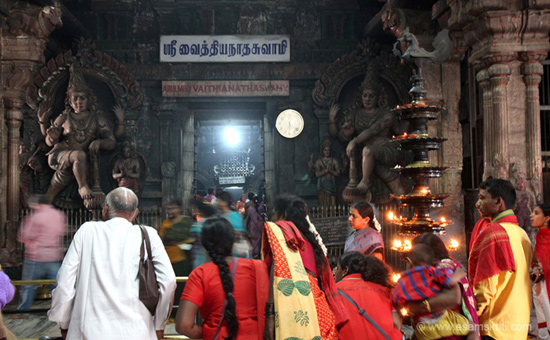 Outside Temple sanctum.
Outside Temple sanctum.
In the temple of Kali in Chidambaram, the Surya Puja
takes place at sunset, drawing crowds of people each year. Attendees gather to
witness the sunlight illuminate the image of the westward-facing pacified Kali,
Brahmacamundeswari. Over the course of three days, the sun's rays progressively illuminate one-third of the image until finally touching her head and brilliant gold crown. In the midst of the smoke-filled temple, the horizontal rays of the sun become visible, captivating eager devotees who strain to catch a glimpse of the illuminated deity. To enhance the spectacle, priests may even extinguish the electric lights of the temple.
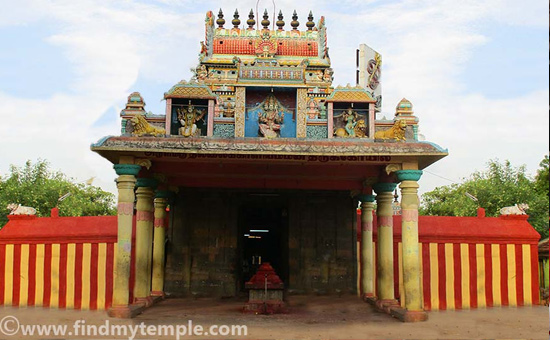 Kali Temple, Chidambaram
Kali Temple, Chidambaram
Meanwhile, in Innambur, a small village 4 km from Kumbakonam, a
remarkable Surya Puja unfolds. During the Suryapuja, light
enters the sanctuary twice each morning, with the direct rays of the rising sun
first touching the lingam, followed fifteen minutes later by light reflected from the temple tank located some 75 feet to the east. At this temple, the image of Vrsha has been deliberately displaced off the east-west axis, allowing sunlight to penetrate the garbhagriha and create a unique and spiritually enriching experience for devotees.
The Nageswarar temple in Kumbakonam hosts
one of the most renowned Surya Puja ceremonies in the area. The temple, dating
back to the 8th century and built during the early Chola period, holds a
significant legend surrounding the Surya puja ritual. According to legends,
Surya was cursed by Visvakarma and afflicted with leprosy. Only through
worshipping Shiva during the Surya puja did the sun regain its original
splendor.
During the three-day festival, countless spectators gather on each side
of the long corridor leading to the sanctum to
witness the rays of the sun touch the deity of the temple, Nageshwara, in the form of a linga protected by the hood of a cobra. Following this event, attendees often visit the shrine of Surya located in the northeast corner of the temple compound. The temple's eastern entrance features a flagpole deliberately positioned approximately 1/3 meter south of the axis, creating a pathway about 1/2 degree wide for the sun to illuminate the lingam.
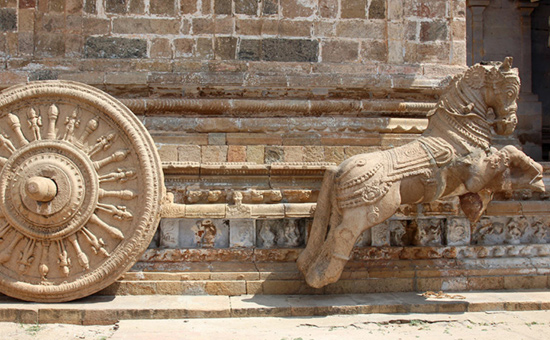 Nageshwarar Temple, Kumbakonam.
Nageshwarar Temple, Kumbakonam.
The Puranic legends of the sun afflicted by
leprosy may reflect a cultural attitude toward the sun that evolved over
time after the temples were originally constructed. Sunspots, natural phenomena
observed on the surface of the sun, might have influenced the connection
between leprosy and the sun.
There are many sthala puranas such as one in Thrunageshwaram where sun suffers
from leprosy due to a curse. The cure for the disease is Shivapuja…This is
demonstrated in the form of sunlight falling directly over the shivalinga.
This is the tradition, and a possible
explanation is that post 1077 CE there was the cosmic phenomenon of increased sun-spots
i.e. black spots on surface of sun due to burn out…hence the tradition of
leprosy might have been developed to explain the natural phenomenon of sunspots
To see album Temples
of Kumbakonam
In 1077 CE, the sun entered a period of unusual sunspot activity, with an unprecedented number of sunspots visible to the naked eye, potentially shaping perceptions of the sun's influence on earthly affairs. This period was the peak of temple-building in Tamil Nadu.
The Concept of Darshana
At the heart of the Surya Puja ritual lies the profound concept of darshan, often translated as 'auspicious sight'. Darshan encompasses the transformative power of vision, through which
blessings and divine energy are transmitted from the gods to the observer. It is an interactive exchange, where the deity 'bestows' darshan upon the devotee, who in turn 'receives' it.
Observing the sun's rays streaming through the temple and illuminating the deity's image offers a unique and sacred opportunity. Witnessing the freshly washed lingam reflecting the dawn sunlight evokes
a sense of being present at the dawn of creation itself. This event
symbolizes the ritual awakening of the deity by sunlight, mirroring the cyclic
emergence of the universe from primordial darkness.
During the Surya Puja, a direct line-of-sight is established between
the sun and the deity, symbolizing a profound connection between Surya and
Shiva. At this juncture, something powerful and mysterious unfolds at a
transcendent level beyond human comprehension. A living geometry is formed,
linking various realms of existence: the individual, the temple, the sun, and
the divine.
The significance of the Surya puja varies across different traditions
and perspectives. For some, it may be a straightforward event where the sun
merely provides additional illumination for the deity. For others, it
represents an opportunity to partake in worship alongside Surya, offering
homage to Lord Shiva in a deeply spiritual communion.
Are Surya Puja and Reflection of Sun Rays on Deity the same
? Yes
Some of the temples in Tamil Nadu where Suryapuja occurs
are –
|
Place
|
Deity
|
|
Ethappor
|
Sambamoorthy
|
|
Mayavaram
|
Vallalar koil
|
|
Aduthurai
|
Suryanarkoil
|
|
Thirukkandiyoor
|
Kandeeshvarar
|
|
Thirukkadaiyur
|
Amrtaghateshvarar
|
|
Chidambaram
|
Tillai Kali
|
|
Tillai Kali
|
Svetaranyeshvarar
|
|
Thirunellikkaval
|
Nellivananathar
|
|
Vaitheeswaran koil
|
Vaidyanathasvami
|
|
Thirunageswaram
|
Naganatha svami
|
|
Thiruppaijili
|
Nilivaneshvarar
|
|
Thiruvaimoor
|
Vaimoornathar
|
|
Thiruvedikkudi
|
Vedapurishvarar
|
|
Innambur
|
Ezhutharinathar
|
|
Thirucchotrutturai
|
Odhanavaneshvarar
|
|
Semponnar koil
|
Swarnapureeshvarar
|
|
Patteshwaram
|
Dhenupurishvarar
|